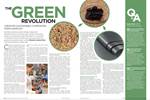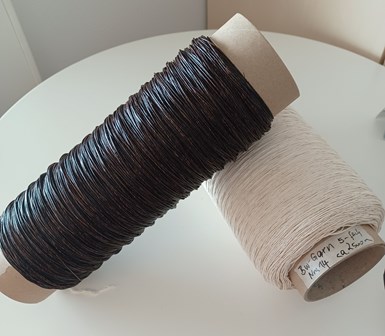DITF researches lignin-based protective coating for natural fiber geotextiles
The bio-based coating was applied to yarns and textile surfaces to extend service life with positive results, suggesting its future application in civil engineering.
Cotton yarns with lignin coating as a protective layer against degradation in soil and reference material without coating. Photo credit, all images: DITF
The German Institutes of Textile and Fiber Research Denkendorf (DITF) are developing a bio-based protective coating, based on lignin, that extends the service life of natural fiber textiles, particularly those used in civil engineering applications.
Depending on humidity and temperature, natural fiber materials can degrade in soil in a matter of months or even a few days. To extend the degradation time and make them suitable for geotextiles, the DITF team is studying the use of its lignin-based coating, which in itself is biodegradable and does not generate microplastics in the soil. Nevertheless, this degradation takes a very long time in nature.
Together with cellulose, lignin forms the building materials for wood — it is the “glue,” holding this composite material together. In paper production, usually only the cellulose is used, so lignin is produced in large quantities as a waste material. So-called kraft lignin remains as a fusible material. In addition, textile production can deal well with thermoplastic materials. Ultimately, these facts are why DITF believes lignin would be suitable for geotextiles.
Nonwoven fabric based on cellulose, coated with the lignin compound as a protective layer against degradation in the soil.
Lignin is brittle by nature. Therefore, it is necessary to blend the kraft lignin with softer biomaterials. For this project, these novel biopolymer compounds of brittle kraft lignin and softer biopolymers were applied to yarns and textile surfaces via adapted coating systems. For this purpose, for example, cotton yarns were coated with lignin at different application rates and evaluated. Biodegradation testing was carried out using soil burial tests in a climatic chamber with temperature and humidity defined precisely according to the standard, and outdoors under real environmental conditions.
According to DITF, the results were positive: The service life of textiles made of natural fibers can be extended by many factors with a lignin coating. The thicker the protective coating, the longer the protection lasts. In the outdoor tests, the lignin coating was still completely intact even after about 160 days of burial.
According to the team, textile materials coated with lignin enable sustainable applications. Providing an adjustable and sufficiently long service life for certain geotextile applications, in addition to still remaining biodegradable, the textiles have the potential to significantly reduce the carbon footprint.
Nevertheless, further research is still needed to establish lignin, which was previously a waste material, as a new valuable material in industrial manufacturing processes in the textile industry.
Related Content
-
Sulapac introduces Sulapac Flow 1.7 to replace PLA, ABS and PP in FDM, FGF
Available as filament and granules for extrusion, new wood composite matches properties yet is compostable, eliminates microplastics and reduces carbon footprint.
-
Cutting 100 pounds, certification time for the X-59 nose cone
Swift Engineering used HyperX software to remove 100 pounds from 38-foot graphite/epoxy cored nose cone for X-59 supersonic aircraft.
-
The potential for thermoplastic composite nacelles
Collins Aerospace draws on global team, decades of experience to demonstrate large, curved AFP and welded structures for the next generation of aircraft.















